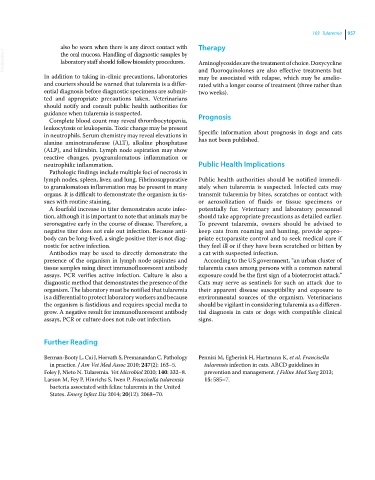Page 1019 - Clinical Small Animal Internal Medicine
P. 1019
103 Tularemia 957
also be worn when there is any direct contact with Therapy
VetBooks.ir the oral mucosa. Handling of diagnostic samples by Aminoglycosides are the treatment of choice. Doxycycline
laboratory staff should follow biosafety procedures.
In addition to taking in‐clinic precautions, laboratories and fluoroquinolones are also effective treatments but
may be associated with relapse, which may be amelio-
and couriers should be warned that tularemia is a differ- rated with a longer course of treatment (three rather than
ential diagnosis before diagnostic specimens are submit- two weeks).
ted and appropriate precautions taken. Veterinarians
should notify and consult public health authorities for
guidance when tularemia is suspected. Prognosis
Complete blood count may reveal thrombocytopenia,
leukocytosis or leukopenia. Toxic change may be present
in neutrophils. Serum chemistry may reveal elevations in Specific information about prognosis in dogs and cats
alanine aminotransferase (ALT), alkaline phosphatase has not been published.
(ALP), and bilirubin. Lymph node aspiration may show
reactive changes, pyogranulomatous inflammation or
neutrophilic inflammation. Public Health Implications
Pathologic findings include multiple foci of necrosis in
lymph nodes, spleen, liver, and lung. Fibrinosuppurative Public health authorities should be notified immedi-
to granulomatous inflammation may be present in many ately when tularemia is suspected. Infected cats may
organs. It is difficult to demonstrate the organism in tis- transmit tularemia by bites, scratches or contact with
sues with routine staining. or aerosolization of fluids or tissue specimens or
A fourfold increase in titer demonstrates acute infec- potentially fur. Veterinary and laboratory personnel
tion, although it is important to note that animals may be should take appropriate precautions as detailed earlier.
seronegative early in the course of disease. Therefore, a To prevent tularemia, owners should be advised to
negative titer does not rule out infection. Because anti- keep cats from roaming and hunting, provide appro-
body can be long‐lived, a single positive titer is not diag- priate ectoparasite control and to seek medical care if
nostic for active infection. they feel ill or if they have been scratched or bitten by
Antibodies may be used to directly demonstrate the a cat with suspected infection.
presence of the organism in lymph node aspirates and According to the US government, “an urban cluster of
tissue samples using direct immunofluorescent antibody tularemia cases among persons with a common natural
assays. PCR verifies active infection. Culture is also a exposure could be the first sign of a bioterrorist attack.”
diagnostic method that demonstrates the presence of the Cats may serve as sentinels for such an attack due to
organism. The laboratory must be notified that tularemia their apparent disease susceptibility and exposure to
is a differential to protect laboratory workers and because environmental sources of the organism. Veterinarians
the organism is fastidious and requires special media to should be vigilant in considering tularemia as a differen-
grow. A negative result for immunofluorescent antibody tial diagnosis in cats or dogs with compatible clinical
assays, PCR or culture does not rule out infection. signs.
Further Reading
Berman‐Booty L, Cui J, Horvath S, Premanandan C. Pathology Pennisi M, Egberink H, Hartmann K, et al. Francisella
in practice. J Am Vet Med Assoc 2010; 247(2): 163–5. tularensis infection in cats. ABCD guidelines in
Foley J, Nieto N. Tularemia. Vet Microbiol 2010; 140: 332–8. prevention and management. J Feline Med Surg 2013;
Larson M, Fey P, Hinrichs S, Iwen P. Francisella tularensis 15: 585–7.
bacteria associated with feline tularemia in the United
States. Emerg Infect Dis 2014; 20(12): 2068–70.

